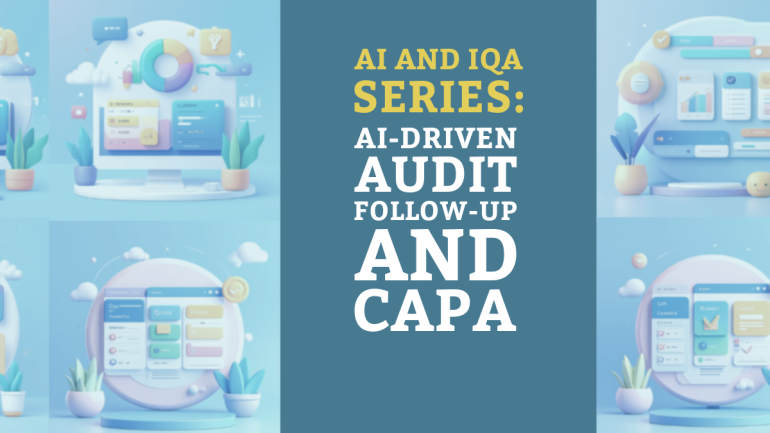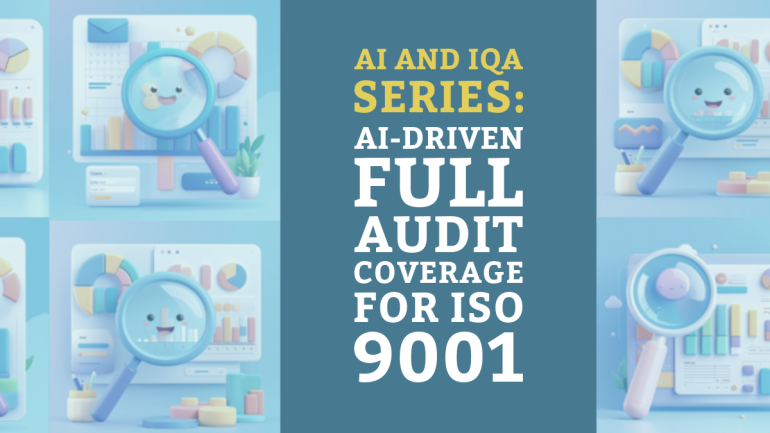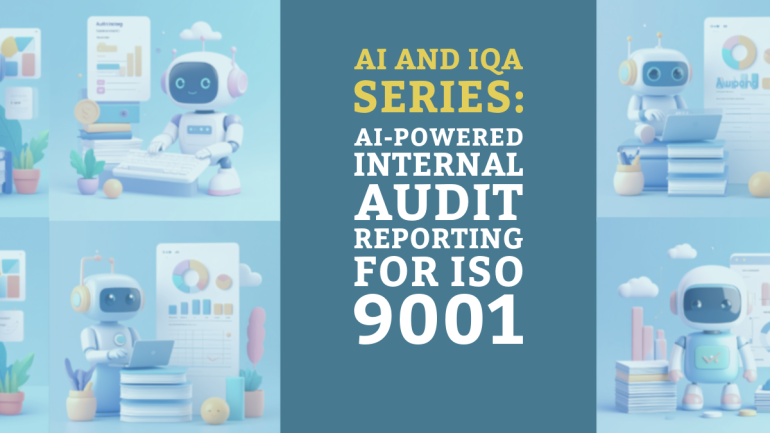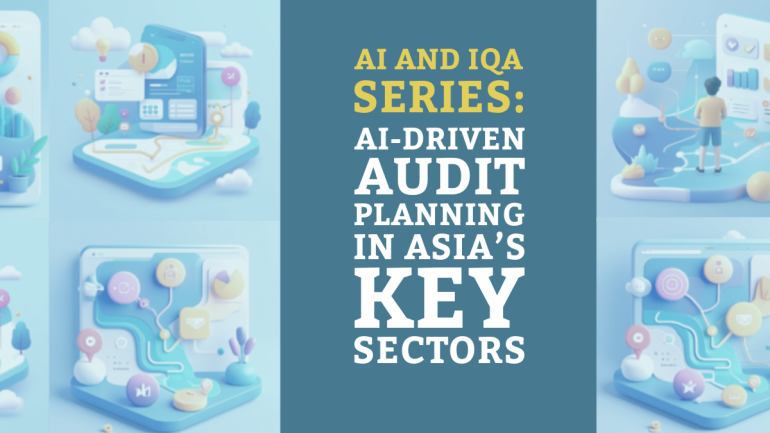Table of Contents
TL;DR: AI Audit Follow-up & CAPA
- AI tools are revolutionizing audit follow-up and CAPA management across Asia, enabling faster closure of non-conformities and continuous monitoring of corrective and preventive actions aligned with ISO 9001 and ISO 19011.
- Real-world examples from manufacturing, healthcare, finance, and education sectors in Singapore, Japan, South Korea, and Malaysia show tangible improvements in quality control, compliance tracking, and risk mitigation.
- Organizations are shifting from periodic audits to continuous compliance monitoring, allowing earlier detection of risks, predictive CAPA actions, and more robust assurance of quality system effectiveness.
- Human oversight remains critical: AI assists by automating data analysis and tracking, but auditors are essential for validating findings, interpreting insights, and ensuring ISO-aligned audit governance.
ISO 9001 quality management systems require regular internal audits (per ISO 19011 guidelines) to ensure processes comply with standards and drive continual improvement. Traditionally, compiling internal audit reports is a labor-intensive task – auditors must gather evidence, map findings to ISO 9001 clauses, and document nonconformities and improvements. In 2023–2024, organizations across Asia began leveraging Artificial Intelligence (AI) to streamline this reporting process. AI tools (including machine learning and generative AI) are being used to draft audit documents, summarize findings, and check report quality, all while adhering to ISO 19011’s principles of accuracy and objectivity. The Asia-Pacific region is at the forefront of this trend – reports show APAC businesses lead in advanced AI use for audit, with Singapore scoring highest in AI readiness (70.1/100) for business and government. Internal audit teams are starting to employ natural language processing (NLP) for document review and generative AI for drafting audit reports. Source This regional momentum sets the stage for faster, more insightful ISO 9001 internal audits, provided auditors maintain oversight per ISO 19011 guidance. Below, we explore real examples from industries like manufacturing, healthcare, finance, and education, highlighting how AI assists in internal audit reporting and the tangible benefits realized.
Manufacturing: Streamlining Quality Audit Reports
Manufacturing firms in Asia are embracing AI to improve the efficiency of internal quality audits. A notable example comes from the manufacturing and packaging sector: WestRock, a global packaging company, demonstrated how generative AI can transform internal audits. In late 2023, WestRock’s internal audit team adopted an AI platform to automate parts of the audit process – drafting audit objectives, creating risk/control matrices, and generating the audit report. The AI was able to compile consistent, high-quality audit summaries in far less time than manual methods. Source By automating report compilation, WestRock’s auditors saved significant effort and could reallocate over 100 hours per audit to higher-value activities. This meant more time on the factory floor engaging with process owners and devising improvements, rather than crunching paperwork. The outcome was faster audit cycles and standardized reports, with AI ensuring no required clause was overlooked.
Asian manufacturers are observing similar gains. For instance, Siemens has used AI in auditing its production processes (predicting equipment failures and optimizing maintenance), and AI-driven quality control audits are being piloted in Japanese automotive plants. Early results across manufacturing show time savings of 50–70% in report preparation and improved consistency in mapping findings to ISO 9001 requirements. By automating routine audit documentation, AI allows Asia’s industrial auditors to focus on strategic analysis, thus enhancing both efficiency and compliance in ISO 9001 internal audits.
Healthcare: Enhancing Audit Quality in Hospitals
In the healthcare industry, maintaining ISO 9001 compliance is critical to ensuring high-quality patient care and safety. Hospitals and medical device manufacturers in Asia have begun to experiment with AI to support internal quality audits and reporting. Early adopters report that AI-powered document analysis can rapidly review vast amounts of records – such as training files, procedure checklists, and incident reports – to flag potential nonconformities for auditors.
A large hospital network in Singapore piloted an NLP-based tool to assist with ISO 9001:2015 internal audits of its clinical operations. The AI was used to scan policy documents and prior audit reports to prepare a draft audit checklist aligned to ISO 9001 clauses, ensuring auditors didn’t miss any requirements. Auditors then conducted the audit and fed their observations back into the tool, which automatically generated a first draft of the internal audit report. This draft summarized each finding and even suggested which ISO 9001 clause each issue pertained to. Internal teams noted substantial time saved in report writing and more thorough coverage of compliance points.
Another example comes from a medical technology manufacturer in Japan that integrated an AI module into its electronic QMS. The AI performs real-time checks during internal audits of production quality records, instantly comparing observed data against ISO 9001 requirements. Deviations are highlighted for the auditor, who can immediately record them in the audit report. This has led to faster identification of issues and more accurate audit reports, with reported outcomes including improved accuracy of audit findings (reducing human error) and quicker turnaround in completing audit reports (cutting report preparation time from two weeks to a few days).
Finance: AI in Internal Audits for Compliance and Efficiency
Financial institutions in Asia – banks, insurers, and fintech companies – are leveraging AI to automate elements of their internal audits, even as they maintain ISO 9001 or similar quality certifications for certain processes (e.g., customer service, IT support, or back-office operations). In Singapore and Malaysia, several banks have reported experimenting with generative AI to draft and proofread internal audit reports for operational audits. The AI can ingest audit workpapers and meeting minutes, then produce a coherent summary of findings and recommended actions. This helps ensure consistent report formatting and phrasing, reducing the review cycles needed.
In Japan, Big Four audit firms are actively integrating AI into their audit platforms and sharing these innovations with financial audit clients. KPMG’s Clara smart audit platform, for example, introduced generative AI capabilities that assist audit teams in multiple ways – the AI can review and flag risks in documents like meeting minutes, help design appropriate audit test procedures, and “quickly summarize and suggest improvements to audit documentation.” Though used in external financial audits, these capabilities are equally applicable to internal auditors reviewing quality management processes.
Education: AI-Assisted Audits in Universities and Schools
Perhaps one of the clearest case studies of AI in ISO 9001 internal audits comes from the education sector in Southeast Asia. A 2023 study in the Philippines demonstrated an AI-enabled approach to internal quality audits at universities. Many Higher Education Institutions (HEIs) are ISO 9001-certified for their academic and administrative processes, and they conduct regular internal audits to ensure compliance.
Researchers developed a custom AI (using a Long Short-Term Memory neural network) trained on five years’ worth of internal audit findings from Philippine universities. This AI was tasked with analyzing audit reports and automatically matching each audit finding to the relevant ISO 9001:2015 clause. In trials, the AI model achieved an impressive 82.15% classification accuracy, correctly predicting the ISO clause for 70% of examined audit findings. The AI could then generate useful and precise audit report content for the university’s quality office. Essentially, once auditors complete an internal audit, the AI helps draft the audit report by populating it with the categorized findings and even recommended wording aligned to each ISO clause.
Beyond this case, other educational institutions in Asia are adopting AI chatbots as “virtual ISO consultants” to guide staff in preparing for audits. Some colleges use AI QMS assistants to answer auditors’ questions on demand (drawing from institutional data) and to check draft audit reports for completeness. These real-world implementations highlight how AI can serve as a knowledge partner, ensuring internal audit reporting not only saves time but also enhances compliance with ISO 9001’s requirements.
Ensuring ISO 19011 Alignment: Oversight and Quality Control
Across all these examples – from factories to hospitals to financial firms – a common theme is that AI is used in alignment with ISO 19011 guidelines, which emphasize auditor competence, ethics, and evidence-based reporting. Organizations in Asia treat AI as an assistive tool rather than a replacement for the auditor’s judgment. Human oversight remains essential at every step: internal auditors review AI-generated content for accuracy, just as they would review a junior auditor’s work. This approach echoes ISO 19011’s principle of due professional care, ensuring that even when AI drafts the report, a qualified auditor validates that findings are supported by evidence and conform to reality.
AI also improves the traceability and completeness of audit records. AI systems can ensure that for every audit finding, the corresponding evidence and standard clause are documented – essentially acting as a quality check on the report. In the Philippine HEI case, the AI’s mapping of findings to ISO clauses ensures auditors don’t miss linking an issue to the standard. This makes internal audit reports more robust and ready for external auditor scrutiny.
Asian organizations have focused on auditor training to work effectively with these AI tools. Internal auditors are being upskilled in data analysis and “prompt engineering” (crafting effective queries for AI) so they can harness AI properly. This ensures auditors remain competent (an ISO 19011 mandate) in an AI-enhanced environment. By combining technology with human expertise, companies achieve both efficiency and compliance.
Outcomes and Benefits
Real-world implementations of AI in internal audit reporting have yielded tangible benefits across Asia. A recurring advantage is significant time savings in preparing audit reports. Generative AI can produce first drafts of reports in minutes, a task that used to take auditors many hours. This is evidenced by cases like a global manufacturer saving over 100 hours per audit through AI-driven automation, or the university study in the Philippines where report drafting was greatly accelerated by AI assistance.
Quality improvements are another key outcome. AI-driven standardization means reports are more uniform and less prone to human error. In Singapore, one service provider automated its ISO compliance reporting so that their software generated internal audit finding reports automatically, ensuring nothing was missed. Likewise, PwC Japan’s use of AI resulted in more consistent application of evaluation criteria and better-documented rationales in audit assessments.
These improvements directly contribute to stronger ISO 9001 compliance. Faster reporting cycles allow organizations to address identified nonconformities and corrective actions sooner, enhancing overall quality performance. Several Asian companies also report enhanced auditor morale – auditors can focus on analytical aspects of audits rather than paperwork. This aligns with the global trend that AI is augmenting auditor capabilities, not replacing them. Auditors indicate that having an AI “assistant” makes the audit process more insightful and less tedious.
From a compliance perspective, the risk of missing a requirement is reduced. AI’s comprehensive data processing ensures that even subtle issues or neglected clauses are brought to attention. Some organizations report improved readiness for external ISO audits – when internal audit reports are detailed and standardized, certification bodies find fewer issues during surveillance audits, leading to smoother renewals.
Conclusion: A New Era of AI-Assisted Auditing in Asia
The integration of AI into ISO 9001 internal audit reporting in Asia is still in its early stages, but the progress from 2023 to 2024 is highly encouraging. Asian organizations, particularly in Singapore, Japan, South Korea, and Malaysia, are leveraging AI tools to transform internal audits from a static, manual exercise into a dynamic, technology-enhanced process. Real-world examples show that AI can assist auditors at each step: planning (suggesting audit plans and checklists), execution (analyzing data and identifying issues), and reporting (drafting and reviewing audit reports).
Importantly, these advancements are happening in alignment with international best practices. ISO 19011 provides the roadmap for effective auditing, and AI is being used to travel that road faster – not to take shortcuts. When implemented thoughtfully, AI empowers internal auditors to be more productive and insightful. Asia’s experience also offers lessons on governance and training. Many companies are instituting AI governance frameworks (some referencing ISO/IEC 42001 for AI management) to ensure responsible use of AI in audits. Internal audit teams are training in AI literacy, so they understand the tools at their disposal and their limitations.
In conclusion, AI is helping automate the grunt work of ISO 9001 internal audit reporting in Asia, while enhancing audit quality. The case studies from 2023–2024 show reduced audit cycle times, improved report accuracy, and more effective compliance maintenance. As technology continues to evolve, we can expect even more sophisticated AI applications – perhaps real-time compliance dashboards and AI-driven risk scoring of processes – further aligning with ISO 9001’s proactive ethos. What remains constant is the need for auditors to guide these tools with professional skepticism and integrity, as outlined in ISO 19011. With that balance, Asia’s organizations are pioneering an audit revolution: one where AI and auditors work hand-in-hand to ensure quality systems not only comply, but continually improve.
FAQ
1. How does AI improve the audit follow-up and CAPA process for ISO 9001 compliance?
AI automates tracking of audit findings, monitors CAPA effectiveness in real time, and provides early warnings of potential process failures, enabling organizations to close the loop faster and achieve stronger compliance outcomes.
2. Which industries in Asia are leading AI adoption for audit follow-up and CAPA?
Manufacturing (e.g., NEC, PETRONAS), healthcare (e.g., Samsung Biologics), finance (e.g., banks in Japan and Singapore), and education (e.g., universities in Singapore and Japan) are leading sectors where AI is actively enhancing audit follow-up and CAPA.
3. How does AI align with ISO 19011 guidelines during follow-up activities?
AI strengthens ISO 19011 compliance by ensuring systematic documentation of audit findings, continuous verification of CAPA effectiveness, and timely escalation of unresolved issues — all while maintaining evidence-based audit practices.
4. What are the measurable benefits of AI-driven CAPA management?
Organizations report shorter audit closure times, higher CAPA completion rates, early identification of emerging risks, and reduced recurrence of non-conformities, directly boosting audit efficiency and quality assurance.
5. Can AI fully automate the audit follow-up and CAPA process?
No. AI significantly enhances efficiency and visibility but does not replace auditors. Human validation, professional judgment, and corrective action design are still required to ensure CAPAs are appropriate, effective, and compliant with standards.





